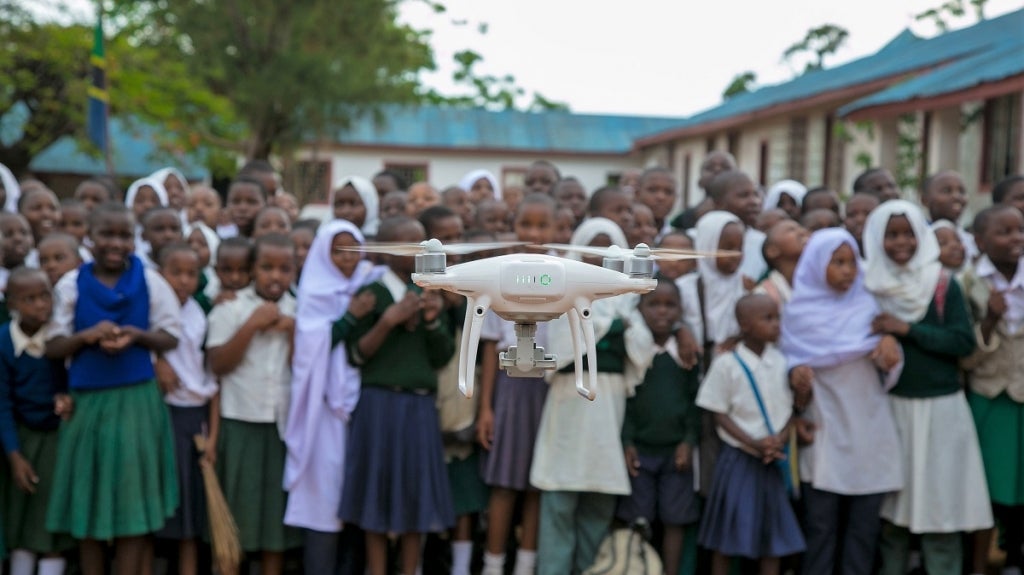
Transport and logistics links in Africa remain costly and unreliable, especially for reaching remote communities. In rural areas, only about a third of Africans live within 2 kilometers of an all-weather road, and the current infrastructure investment gaps in road transport infrastructure in the region amount to billions of dollars annually. The national road density in the region remains less than a quarter of the global average. The intensifying effects of climate change and, in parts of the region, conflict and violence, further hinder the ability of governments and businesses to efficiently and reliably ensure the delivery of goods and services. These gaps also present enormous challenges to meeting the Sustainable Development Goals, from health to agricultural productivity to food security.
In our recent book, Unlocking the Lower Skies: The Costs and Benefits of Deploying Drones across Use Cases in East Africa, we analyzed how uncrewed aerial vehicles (UAVs), or “drones”, could help bridge some of these gaps quickly and effectively.
The analysis finds that in certain contexts and pricing models, drones are already close to or at cost parity with road-based transport modes in medical goods delivery. Our research in Mwanza, a topographically challenging region of Tanzania located partially in Lake Victoria, shows that, while remaining more expensive than overland transport modes, UAVs would be the most cost-effective for carrying laboratory samples, lifesaving items and blood to selected destinations, such as from the mainland to distant islands, and their cost-effectiveness could improve even further by combining several different goods to maximize the utilization of the UAV time and capacity and associated human resources.
Our analysis suggests that UAVs already provide a cost-effective alternative to manned aircraft in humanitarian food aid delivery in conflict situations such as in South Sudan and, likely, other hotspots in Africa, such as the Sahel and the Lake Chad region.
And, while they are not yet cost-competitive for deliveries of large volumes of food staples that are currently transported overland, cargo drones may offer cost savings in indirect ways, by reducing the inventory stock needs and uncertainty in delivery times in contexts where roads are impassable for significant parts of the year, such as in the Lake Kivu area of Rwanda.
Our analysis also finds that drones offer cost and flexibility advantages compared to manned aircraft in mapping, disaster risk, and agricultural applications, and have passed the proof-of-concept stage for the infrastructure inspection use case, as demonstrated by successful applications like in roads inspection in Zanzibar.
Moreover, the cost-effectiveness of UAVs cannot be analyzed without looking at the public health benefits, which may be substantial. Drones can save lives, especially when they allow patients in remote locations to be diagnosed faster, start treatment, or receive blood and other essential medical goods. In climate risk assessment, UAVs may provide quality benefits and time savings compared to satellite imagery while building local technical capacity. Drones can also provide significant security benefits when used in infrastructure inspection and infrastructure works supervision in FCV contexts.
The potential cost and flexibility advantages of drones are further magnified in the context of the COVID-19 recovery. The COVID-19 global health and economic crisis has painfully reaffirmed that essential goods supply chains across not only Sub-Saharan Africa but also many developed countries are highly vulnerable not only to climatic events but also to pandemics and many other shocks. The global experience with COVID-19 shows that traditional supply chains, especially health-related ones, can be substantially disrupted in the event of a pandemic, creating scarcity for medical products, food, hospital beds and personnel. By offering contactless transport, drones can be a solution for maintaining/restoring supply chains while protecting people from infection when delivering critical goods like medical products and food—an approach successfully implemented during the COVID-19 pandemic by Rwanda and Ghana. Drones can also step in where traditional transport modes cannot in the current environment of severe in-person travel restrictions in many countries – in areas such as risk mapping, crop inspections, infrastructure inspections and monitoring.
The ongoing pandemic presents a unique opportunity to integrate UAVs – and other out-of-the-box mobility solutions – across development applications to ensure long-term resilience. It is an opportunity to make supply chains more sustainable and resilient by complementing traditional solutions where they fall short: most often, at the last leg.
And this is just the beginning. It is safe to assume that, over the next few years, the global community will come up with many exciting new ways of using drones for development. As with many other disruptive solutions, however, technology tends to evolve much faster than regulation. If we are to leverage the full potential of drones for development, the regulatory environment needs to catch up and create the proper conditions for these technologies to take flight. Our team stands ready to work with countries in Africa and around the world to make this happen.
Want to learn more about our methodology and findings? Please refer to our publication, “Unlocking the Lower Skies: The Costs and Benefits of Deploying Drones across Use Cases in East Africa”. The report was prepared with contributions from the UK government, the Ministry of Land, Infrastructure and Transport (MOLIT) of Republic of Korea through the Korean Institute of Aviation Safety Technology (KIAST) and the African Drone Forum.



Join the Conversation